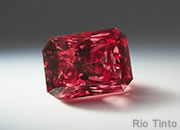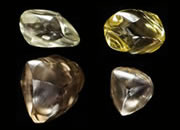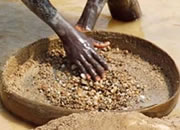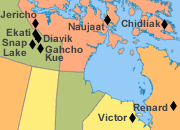Home » Minerals » Diamond » Diamond Information
Interesting Facts and Information about Diamonds
If you know all of these facts, you are a genuine diamond expert!
Author: Hobart M. King, PhD, GIA Graduate Gemologist
 |
Canada: Future Production Leader?
Canada's first commercial gem-quality diamond mines delivered their first production in the late 1990s. In the short years since, Canadian diamond mines have become some of the world's leading producers.
 |
The Hardest Natural Substance!
With a hardness of ten on the Mohs Scale, diamond is the hardest natural substance. Diamonds are so hard that the only tools that can be used to cut a diamond must be made from another diamond.
 |
You Can Mine Diamonds Here!
There is only one diamond mine in the world where anyone can be a miner. That mine is at Crater of Diamonds State Park in Arkansas. For a few dollars you can mine for a day and keep anything you find.
 |
India: The First Commercial Producer
Diamonds were discovered in India at least 2400 years ago, and India was the first commercial producer of diamonds. The country dominated commercial diamond production until South American discoveries in the 1730s.
 |
Diamonds From Space!
Diamonds from space are a reality. They have been found in some meteorites, and the impact of meteorites with Earth is thought to produce enough heat and pressure to transform carbon into diamonds.
 |
Octahedral Diamonds
Many uncut diamonds have a geometric shape. These natural diamond crystals commonly are in the form of an octahedron. This shape is similar to two four-sided pyramids connected at their base to form a geometric solid with eight faces.
 |
Colored Diamonds
Colored diamonds are diamonds with a noticeable bodycolor when viewed in the face-up position. They can be yellow, brown, green, red, orange, pink, blue, or any other color.
 |
The Gem of Heat and Pressure
Diamonds are high-temperature, high-pressure minerals. They do not form naturally at Earth's surface or at shallow depths. The conditions where they can form are in Earth's mantle about 100 miles below the surface.
 |
Diamonds For Drilling
Drilling oil and gas wells down through thousands of feet of rock requires a tough drill bit. Small diamonds are embedded into the cutting surfaces of these bits. The extremely hard diamonds wear away the rock as the drill bit is turned in the hole.
 |
Diamond Anvils
Diamonds form at high pressure, and that makes them stable in such an environment. When scientists need to place small objects under ultra-high pressure, they often press them between two pieces of diamond known as "diamond anvils."
 |
Synthetic Diamonds for Industry
People have been able to manufacture diamonds since the 1950s. At first the cost was very high. Now, over 100 tons of synthetic diamonds are produced every year. Most of these diamonds are used to make cutting tools and abrasives.
 |
One-Element Gemstone
Diamonds have a simple composition. They are composed of carbon. Diamond is the only gemstone composed of just one element. Trace amounts of other elements exist in diamonds as impurities. These can give diamond a slight color.
 |
The Largest Diamond Deposit
The largest known diamond deposit is at Popigai Crater in Russia. There, an asteroid impact provided enough heat and energy to convert carbon surface materials into diamond. The diamonds are of industrial quality.
 |
Record Price for a Rough Diamond
The highest price ever paid for a rough diamond was $35.3 million. Chow Tai Fook, Hong Kong's largest jewelry company, purchased the 507-carat "Cullinan Heritage" in 2010. It was cut into 24 D-color, internally flawless diamonds.
 |
Synthetic Diamonds for Jewelry
People have successfully made lab-grown diamonds for use in fine jewelry. The stones are undistinguishable from natural diamonds, even when observed by experienced gemologists. They can be identified only by laboratory tests.
 |
USA: Almost No Diamond Production
Although the United States is the largest consumer of gem diamonds, it has almost no production. The only mine is a state park where tourists can pay a fee to look for diamonds. The park yields just a few hundred carats per year.
 |
The Mine of Famous Diamonds
Most of the world's most famous diamonds have been found at the Cullinan Diamond mine in the Gauteng Province of South Africa. An example is the 507-carat "Cullinan Heritage," a Type IIA diamond of extreme quality and clarity.
| More Diamonds |
 |
Colored Diamonds |
 |
Red Diamonds |
 |
US Diamond Mines |
 |
Diamond |
 |
Blood Diamonds |
 |
World*s Largest Diamonds |
 |
Diamonds Do Not Form From Coal |
 |
Canadian Diamond Mines |

Find Other Topics on Geology.com:

|

| ||

|

| ||

|

| ||

|

|



